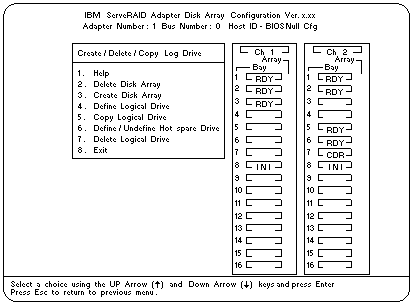| Physical RDY Drives Available |
Logical Drive RAID Level |
Hot-Spare Available |
|---|---|---|
| 1 | 0 | No |
| 2 | 1 | No |
| 3 | 5 | No |
| 4-9 | 5 | Yes |
For example, if the server contains six drives that are in the RDY state,
the EZ-RAID configuration feature will use five drives to create one disk array and define it as one
RAID level 5 logical drive. The remaining drive is defined as a hot-spare drive.
If you want to use the EZ-RAID configuration feature to create multiple disk arrays,
you might need to change the device states of some of the drives to prevent them from
being included in the first array.
To create a disk array using the EZ-RAID configuration feature:
- Start the ServeRAID Configuration program (see 'Starting the ServeRAID Configuration Program').
- If you want to include all RDY drives in the array, continue with step 3.
Otherwise, change the device states of the RDY drives that you do not want to
include in the array to SBY. To do this:
- Select Rebuild/Device Management from the Main Menu, then, press Enter.
- Select Set Device State from the next menu, then, press Enter.
- Use the Up Arrow (
 ) or Down Arrow (
) or Down Arrow (  ) key to highlight the drive that you do not want to
include in the array, then, press Enter.
) key to highlight the drive that you do not want to
include in the array, then, press Enter.
- When the drive states pop-up window appears, select SBY, then, press Enter.
- Repeat steps 2b through 2d for each RDY drive that you do not want to include in the array, then, press Esc to return to the Main Menu.
- Note:
After you run EZ-RAID configuration, you
can change the device states back to RDY.
- Select EZ-RAID Configuration from the Main Menu, then, press Enter. Information about the disk-array configuration appears on the screen.
- When the Confirm pop-up window appears, select Yes, then, press Enter. The drives are automatically initialized. RAID level 5 drives are synchronized in the background.
- If you are creating multiple arrays and you set some of the devices to another state using the procedure in step 2, use that procedure to set the devices for the next array to RDY. Then, return to step 3 to create the next array. If you have finished creating the arrays, continue with Step 6.
- When the initialization process completes, you have completed the required steps for creating a ServeRAID disk-array configuration.
- Back up the disk-array configuration information to diskette. See 'Backing Up the Disk-Array Configuration' for instructions.
- You are now ready to install the operating system. Refer to the information provided in the ServerGuide package.
Creating Disk Arrays Manually: You can use the
Create/Delete/Copy Log Drive menu to create the disk
arrays manually. You also can use this menu to define the
logical and hot-spare drives for the arrays. You must
define at least one logical drive for each array.
To create a disk array manually:
- Start the ServeRAID Configuration program (see 'Starting the ServeRAID Configuration Program').
- Select Create/Delete/Copy Log Drive from the Main Menu, then, press Enter.
A screen similar to the following appears.

- Select Create Disk Array, then, press Enter
- Use the Up Arrow (
 ) or Down Arrow (
) or Down Arrow (  ) key to highlight
each drive that you want to include in the array, then, press Enter
) key to highlight
each drive that you want to include in the array, then, press Enter
The cursor is active in the Array / Bay selection list. (You must press Enter to select each drive. As you select each drive, the state of that drive changes from ready (RDY) to online (ONL).)Note:
- Hard disk drive capacities influence the way you create arrays. Drives in the array can be of different capacities, but the ServeRAID controller treats them as if they all have the capacity of the smallest disk drive. (See 'Hard Disk Drive Capacities' for more information.)
- If you change the mind after selecting the drives for an array, you can delete the array (by selecting Delete Disk Array from the Create/Delete Copy Log Drive menu), then, begin again.
- After you select all of the drives that you want to include in the array,
press Esc to return to the Create/Delete Copy Log Drive menu.
Note: When the stripe-unit size is 8 K (the default setting) or 16 K (a manual setting), the maximum number of physical drives in an array is 16. When the stripe-unit size is 32K or 64K (both are manual settings), the maximum number of physical drives in an array is eight.
- If you want to create another array, return to Step 3. Otherwise, continue with step 7.
- You must define at least one logical drive for each new array. Continue with 'Defining Logical Drives'
Back to
Please see the LEGAL - Trademark notice.
Feel free - send a  for any BUG on this page found - Thank you.
for any BUG on this page found - Thank you.